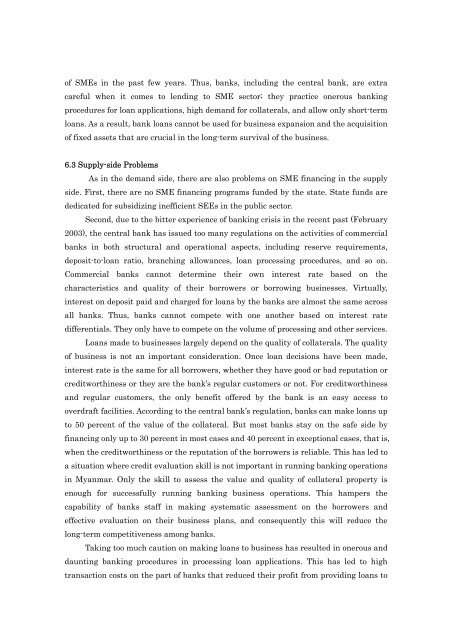Title Financing Small and Medium Enterprises in Myanmar Author(s ...
Title Financing Small and Medium Enterprises in Myanmar Author(s ...
Title Financing Small and Medium Enterprises in Myanmar Author(s ...
You also want an ePaper? Increase the reach of your titles
YUMPU automatically turns print PDFs into web optimized ePapers that Google loves.
of SMEs <strong>in</strong> the past few years. Thus, banks, <strong>in</strong>clud<strong>in</strong>g the central bank, are extra<br />
careful when it comes to lend<strong>in</strong>g to SME sector; they practice onerous bank<strong>in</strong>g<br />
procedures for loan applications, high dem<strong>and</strong> for collaterals, <strong>and</strong> allow only short-term<br />
loans. As a result, bank loans cannot be used for bus<strong>in</strong>ess expansion <strong>and</strong> the acquisition<br />
of fixed assets that are crucial <strong>in</strong> the long-term survival of the bus<strong>in</strong>ess.<br />
6.3 Supply-side Problems<br />
As <strong>in</strong> the dem<strong>and</strong> side, there are also problems on SME f<strong>in</strong>anc<strong>in</strong>g <strong>in</strong> the supply<br />
side. First, there are no SME f<strong>in</strong>anc<strong>in</strong>g programs funded by the state. State funds are<br />
dedicated for subsidiz<strong>in</strong>g <strong>in</strong>efficient SEEs <strong>in</strong> the public sector.<br />
Second, due to the bitter experience of bank<strong>in</strong>g crisis <strong>in</strong> the recent past (February<br />
2003), the central bank has issued too many regulations on the activities of commercial<br />
banks <strong>in</strong> both structural <strong>and</strong> operational aspects, <strong>in</strong>clud<strong>in</strong>g reserve requirements,<br />
deposit-to-loan ratio, branch<strong>in</strong>g allowances, loan process<strong>in</strong>g procedures, <strong>and</strong> so on.<br />
Commercial banks cannot determ<strong>in</strong>e their own <strong>in</strong>terest rate based on the<br />
characteristics <strong>and</strong> quality of their borrowers or borrow<strong>in</strong>g bus<strong>in</strong>esses. Virtually,<br />
<strong>in</strong>terest on deposit paid <strong>and</strong> charged for loans by the banks are almost the same across<br />
all banks. Thus, banks cannot compete with one another based on <strong>in</strong>terest rate<br />
differentials. They only have to compete on the volume of process<strong>in</strong>g <strong>and</strong> other services.<br />
Loans made to bus<strong>in</strong>esses largely depend on the quality of collaterals. The quality<br />
of bus<strong>in</strong>ess is not an important consideration. Once loan decisions have been made,<br />
<strong>in</strong>terest rate is the same for all borrowers, whether they have good or bad reputation or<br />
creditworth<strong>in</strong>ess or they are the bank’s regular customers or not. For creditworth<strong>in</strong>ess<br />
<strong>and</strong> regular customers, the only benefit offered by the bank is an easy access to<br />
overdraft facilities. Accord<strong>in</strong>g to the central bank’s regulation, banks can make loans up<br />
to 50 percent of the value of the collateral. But most banks stay on the safe side by<br />
f<strong>in</strong>anc<strong>in</strong>g only up to 30 percent <strong>in</strong> most cases <strong>and</strong> 40 percent <strong>in</strong> exceptional cases, that is,<br />
when the creditworth<strong>in</strong>ess or the reputation of the borrowers is reliable. This has led to<br />
a situation where credit evaluation skill is not important <strong>in</strong> runn<strong>in</strong>g bank<strong>in</strong>g operations<br />
<strong>in</strong> <strong>Myanmar</strong>. Only the skill to assess the value <strong>and</strong> quality of collateral property is<br />
enough for successfully runn<strong>in</strong>g bank<strong>in</strong>g bus<strong>in</strong>ess operations. This hampers the<br />
capability of banks staff <strong>in</strong> mak<strong>in</strong>g systematic assessment on the borrowers <strong>and</strong><br />
effective evaluation on their bus<strong>in</strong>ess plans, <strong>and</strong> consequently this will reduce the<br />
long-term competitiveness among banks.<br />
Tak<strong>in</strong>g too much caution on mak<strong>in</strong>g loans to bus<strong>in</strong>ess has resulted <strong>in</strong> onerous <strong>and</strong><br />
daunt<strong>in</strong>g bank<strong>in</strong>g procedures <strong>in</strong> process<strong>in</strong>g loan applications. This has led to high<br />
transaction costs on the part of banks that reduced their profit from provid<strong>in</strong>g loans to




![Title [書評] 廣田義人著『東アジア工作機械工業の技術形成 ... - ARRIDE](https://img.yumpu.com/47139953/1/184x260/title-arride.jpg?quality=85)






